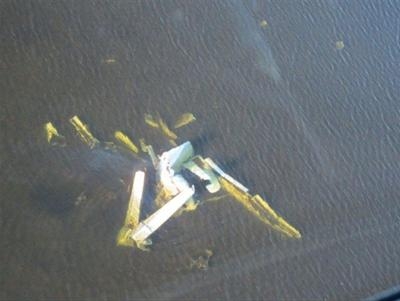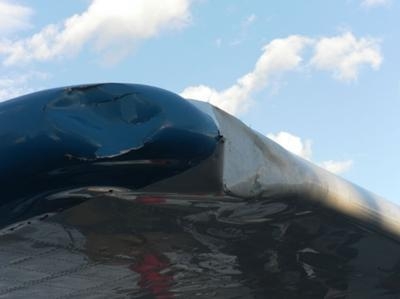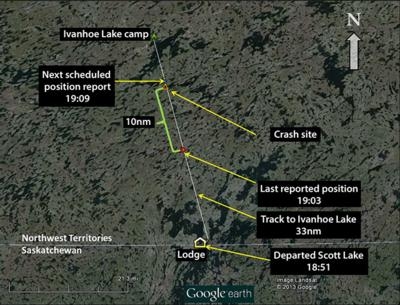Said Pilot Made Poor Choices, Including Not Reporting Illness, Taking Off In A Damaged Airplane
The Transportation Safety Board (TSB) of Canada has released a final report from an accident which occurred near Ivanhoe Lake in Canada's Northwest Territories.

According to the report, the float-equipped Transwest Air Limited Partnership DHC-3 turbine Otter (registration C-FSGD) departed Scott Lake, Northwest Territories, at approximately 1850 Central Standard Time on a 33-nautical mile, day, visual flight rules flight to Ivanhoe Lake, Northwest Territories. The aircraft did not arrive at its destination, and was reported overdue at approximately 2100. The Joint Rescue Coordination Centre Trenton was notified by the company. There was no emergency locator transmitter signal. A search and rescue C-130 Hercules aircraft was dispatched; the aircraft wreckage was located on 23 August 2013, in an unnamed lake, 10 nautical miles north of the last reported position. The pilot, who was the sole occupant of the aircraft, sustained fatal injuries.
The report indicates that the commercial pilot had recently transitioned into the Otter from the DHC-2 Beaver, and was familiar with the area. The night before the accident flight, he reportedly shared a meal with a fellow pilot and then went to bed at approximately 2330. The following morning, both pilots experienced stomach cramps and were feeling unwell.
Transwest's policy provides that if pilots feel unfit to fly due to illness, they are expected to contact the base manager, chief pilot or director of flight operations and remove themselves from flight duty. The pilot would still be paid for a sick day. There is no indication that the occurrence pilot attempted to call in sick.

The pilot had been encountering operational problems throughout the day of the accident. The wind was making it difficult to maneuver the aircraft to the various docks and unloading points. On one of the flights, a water rudder was damaged. The water rudder was repaired at Stony Rapids prior to a flight to Pinkham Lake, Northwest Territories. On arrival at Pinkham Lake, the pilot made approximately 8 attempts to manoeuvre to the unloading spot. Later in the day, while trying to depart Desmarais Lake, the aircraft became stuck near the beach, and the pilot had to use substantial power several times to free the aircraft from sandbars.
The aircraft was also damaged during an approach to land at Scott Lake. The report indicates that the aircraft made a low-altitude turn to the right around the south end of an island onto the final approach toward the lodge. While in a right bank, the right wing tip struck a stand of trees on the point of the island. There was a loud bang, and the aircraft swung to the right. The pilot maintained control and touched down on the water several seconds later. After taxiing to the lodge, the pilot made 2 attempts to dock, after which the pilot brusquely ordered a passenger to vacate the right seat. The pilot then moved from the left seat into the right seat and docked the aircraft with the right wing over the dock. Damage to the right-wing leading edge and fibreglass wing tip was evident and was pointed out to the pilot, but the comment was dismissed (See photo). When the unloading was complete, the pilot immediately called for the lines to be cast off, and taxied away from the dock.
The aircraft, with only the pilot on board, departed for Ivanhoe Lake, Northwest Territories at 1850. The take-off appeared normal, and the aircraft was observed climbing to the north. The aircraft was expected back at Scott Lake by 2030. Shortly before the aircraft was due to return, the lodge manager contacted Transwest Air flight-following personnel in Stony Rapids and requested a position report.

There was no emergency locator transmitter (ELT) signal from the aircraft. The C-130 Hercules tasked by the JRCC commenced a search pattern toward Ivanhoe Lake from the last reported position. The wreckage was discovered on August 23, 2013 at 0526 on track between Scott Lake and Ivanhoe Lake, 10 nn) north of the last automated position report from the airplane's tracking device.
In its findings, the TSB reported causes and contributing factors to be:
- During approach to landing on the previous flight, the right-wing leading-edge and wing tip were damaged by impact with several trees.
- The damage to the aircraft was not evaluated or inspected by qualified personnel prior to take-off.
- Cumulative unmanaged stressors disrupted the pilot's processing of safety-critical information, and likely contributed to an unsafe decision to depart with a damaged, uninspected aircraft.
- The aircraft was operated in a damaged condition and departed controlled flight likely due to interference between parts of the failing wing tip, acting under air loads, and the right aileron.
(Images from the TSB report)
 Unfortunate... ANN/SportPlane Resource Guide Adds To Cautionary Advisories
Unfortunate... ANN/SportPlane Resource Guide Adds To Cautionary Advisories ANN FAQ: Turn On Post Notifications
ANN FAQ: Turn On Post Notifications ANN's Daily Aero-Term (04.29.24): Visual Approach Slope Indicator (VASI)
ANN's Daily Aero-Term (04.29.24): Visual Approach Slope Indicator (VASI) ANN's Daily Aero-Term (04.28.24): Airport Marking Aids
ANN's Daily Aero-Term (04.28.24): Airport Marking Aids ANN's Daily Aero-Linx (04.28.24)
ANN's Daily Aero-Linx (04.28.24)





